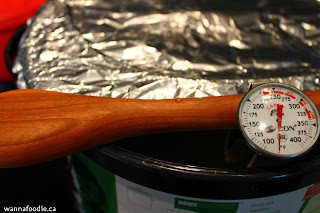In making all of these cheeses, I have been left with an exorbitant amount of whey. Charlie the puppy absolutely loves this, as a bit of this on his kibble like cereal is enough to have him doing flips. The plants have loved it... though that season is coming to a close. I'm using it in bread. I can't quite get around to drinking it... just a mental block, I think. Maybe if I blend it into a smoothie?
One thing that I had to try in using up this whey was to make a whey ricotta. I thought I'd mix it up a little bit and make a whey ricotta using goat's milk whey and whole cow's milk.
I couldn't quite get the double-boiler bit coordinated... it's tough to find a pot big enough to fit a pot that fits two gallons of liquid! Instead, I opted for the single pot but warmed it extra slowly to compensate (it was more than 45 minutes to get to temperature).
The whole process was quite simple - heat, curdle, drain, cheese!
(It probably could have drained a weeeeee bit longer based on this photo...
but it was still soooooo good.)
Punch "whey ricotta" into your search engine and you'll find a plethora of recipes. The basic recipes for whey ricotta require 1-2 gallons of whey, some vinegar as your coagulant, and salt to season it. Only three ingredients! Mary's recipe isn't far off these but adds in whole milk to increase the yield, which is nice because for the effort (albeit addictive effort of cheesemaking), it is nice to produce more than a cupful.
My whey was very fresh after making several different goat cheeses, so it was primed and ready for some ricotta making. I really liked the combination of goat's whey and cow's milk. It added a very nuanced flavour to the final product that, in my opinion, elevated it just slightly over the full cow's milk ricotta that we made a few weeks ago.
A few thoughts:
- I still need to get better at reading and rereading the recipes to ensure that I do what is being asked of me. Yet again, I added something at the wrong time... in this case, the cream in Mary's recipe and, in this case, it did not hinder the final product (in my opinion). That said, one day, I'm going to add the wrong thing at the wrong time and then I'll be left with... milk.
- The fresher your whey, the better your yield. Ok, honestly, I'm not sure why but I bet it has something to do with the suspension of any milk fats in the whey... maybe something to do with settling... hey Cheesepalooza friends, do you know?
- Again, I really really really liked the combination of goat's whey with cow's milk. Such great flavour.
- I felt like this whey ricotta needed to drain even longer than the first ricotta that we made. It seems that the abundance of whey yields a wetter ricotta. I probably could have let mine drain even longer than I did. It was fine as it was... but additional whey could have been released from the final cheese product with a bit more hanging time.
T A S T I N G N O T E S
Appearance - Fluffy, light, fresh.
Nose - Dairy... (I don't think we're very good at these "aroma" descriptions... maybe it is my allergies and lack of a sense of smell in that regard. hahah)
Overall Taste - Fresh, light. Could be used like cottage cheese.
Sweet to Salty - On the side of sweet but not "sweet."
Mild to Robust - Mild.
Mouth Feel - Wet, slight texture. Slight definition of curds but not grainy.
One comment - "I like it better than the first ricotta!"
Now, think about turning that ricotta into ricotta salata...





















2 thought(s):
I am glad to see you tried making true ricotta. It's my favorite cheese, so I am a bit biased. There are a few things to keep in mind when making ricotta, starting with the pH. The way I was taught, the pH of the whey for making ricotta needs to be 5.9-6.0. I personally don't use vinegar, which to my mouth leaves an aftertaste. I now mostly use acidified whey, but if I don't have that, I use citric acid: can you find some? I believe it is used in canning as well. I am thinking of writing a post about ricotta for this month Cheesepalooza, but you can take a look at posts I have written in the past. Feel free to write to me, if you need additional information. I don't consider myself an expert, just one who's done this for a while.
Thanks for the amazing guidance, Simona. I haven't yet purchased or started using pH strips, though I feel as though I need to do that at this stage. I have plenty of citric acid. Do you have a post about citric acid ricotta? I will have to zip over to your lovely site and see... that sounds like another great method, especially since I plan to make some this weekend!
Post a Comment